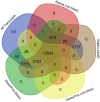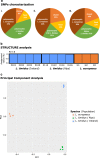Mountain hare transcriptome and diagnostic markers as resources to monitor hybridization with European hares
- PMID: 29206218
- PMCID: PMC5716010
- DOI: 10.1038/sdata.2017.178
Mountain hare transcriptome and diagnostic markers as resources to monitor hybridization with European hares
Abstract
We report the first mountain hare (Lepus timidus) transcriptome, produced by de novo assembly of RNA-sequencing reads. Data were obtained from eight specimens sampled in two localities, Alps and Ireland. The mountain hare tends to be replaced by the invading European hare (Lepus europaeus) in their numerous contact zones where the species hybridize, which affects their gene pool to a yet unquantified degree. We characterize and annotate the mountain hare transcriptome, detect polymorphism in the two analysed populations and use previously published data on the European hare (three specimens, representing the European lineage of the species) to identify 4 672 putative diagnostic sites between the species. A subset of 85 random independent SNPs was successfully validated using PCR and Sanger sequencing. These valuable genomic resources can be used to design tools to assess population status and monitor hybridization between species.
Conflict of interest statement
The authors declare no competing financial interests.
Figures




Similar articles
-
Mountain- and brown hare genetic polymorphisms to survey local adaptations and conservation status of the heath hare (Lepus timidus sylvaticus, Nilsson 1831).Sci Data. 2022 Nov 3;9(1):667. doi: 10.1038/s41597-022-01794-5. Sci Data. 2022. PMID: 36329035 Free PMC article.
-
Introgression of mountain hare (Lepus timidus) mitochondrial DNA into wild brown hares (Lepus europaeus) in Denmark.BMC Ecol. 2006 Nov 15;6:17. doi: 10.1186/1472-6785-6-17. BMC Ecol. 2006. PMID: 17105672 Free PMC article.
-
Overcoming species barriers: an outbreak of Lagovirus europaeus GI.2/RHDV2 in an isolated population of mountain hares (Lepus timidus).BMC Vet Res. 2018 Nov 26;14(1):367. doi: 10.1186/s12917-018-1694-7. BMC Vet Res. 2018. PMID: 30477499 Free PMC article.
-
Unstable dynamics and population limitation in mountain hares.Biol Rev Camb Philos Soc. 2007 Nov;82(4):527-49. doi: 10.1111/j.1469-185X.2007.00022.x. Biol Rev Camb Philos Soc. 2007. PMID: 17944616 Review.
-
The hare and the tortoise: one small step for four SNPs, one giant leap for SNP-kind.Forensic Sci Int Genet. 2010 Feb;4(2):59-61. doi: 10.1016/j.fsigen.2009.08.005. Epub 2009 Sep 2. Forensic Sci Int Genet. 2010. PMID: 20129461 Free PMC article. Review.
Cited by
-
Mountain- and brown hare genetic polymorphisms to survey local adaptations and conservation status of the heath hare (Lepus timidus sylvaticus, Nilsson 1831).Sci Data. 2022 Nov 3;9(1):667. doi: 10.1038/s41597-022-01794-5. Sci Data. 2022. PMID: 36329035 Free PMC article.
-
Development of Diagnostic SNP Markers To Monitor Hybridization Between Sika Deer (Cervus nippon) and Wapiti (Cervus elaphus).G3 (Bethesda). 2018 Jul 2;8(7):2173-2179. doi: 10.1534/g3.118.200417. G3 (Bethesda). 2018. PMID: 29789312 Free PMC article.
-
A new HaCV-EBHSV recombinant lagovirus circulating in European brown hares (Lepus europaeus) from Catalonia, Spain.Sci Rep. 2024 Feb 4;14(1):2872. doi: 10.1038/s41598-024-53201-1. Sci Rep. 2024. PMID: 38311618 Free PMC article.
-
High prevalence and genetic diversity of Treponema paraluisleporidarum isolates in European lagomorphs.Microbiol Spectr. 2024 Jan 11;12(1):e0177423. doi: 10.1128/spectrum.01774-23. Epub 2023 Dec 14. Microbiol Spectr. 2024. PMID: 38095473 Free PMC article.
References
Data Citations
-
- 2017. NCBI Sequence Read Archive. SRP095715
-
- Marques J. P. 2017. Figshare. http://dx.doi.org/10.6084/m9.figshare.c.3682042 - DOI
-
- 2016. NCBI Sequence Read Archive. SRP055741
References
-
- Thulin C. G. The distribution of mountain hares Lepus timidus in Europe: A challenge from brown hares L. europaeus? Mamm. Rev. 33, 29–42 (2003).
-
- Reid N. & Montgomery W. I. Is naturalisation of the brown hare in Ireland a threat to the endemic Irish hare? Biol. Environ. 107, 129–138 (2007).
-
- Reid N. European hare (Lepus europaeus) invasion ecology: Implication for the conservation of the endemic Irish hare (Lepus timidus hibernicus). Biol. Invasions 13, 559–569 (2011).
-
- Caravaggi A., Montgomery W. I. & Reid N. Range expansion and comparative habitat use of insular, congeneric lagomorphs: invasive European hares Lepus europaeus and endemic Irish hares Lepus timidus hibernicus. Biol. Invasions 17, 687–698 (2015).
Publication types
MeSH terms
Grants and funding
LinkOut - more resources
Full Text Sources
Other Literature Sources
Miscellaneous

